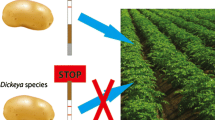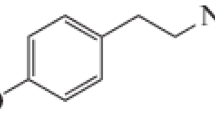Abstract
Various parameters,e.g. types of microtiter plate for DAS-ELISA (double antibody sandwich-enzyme-linked immunosorbent assay), use of fresh or frozen amplifier solutions for enzyme-amplified-ELISA, and use of sodium diethyldithiocarbamate (NaDIECA) in sample buffer in cocktail-ELISA were evaluated for the detection of potato viruses A, M, S, X, Y and leafroll from potato foliage. Dynatech Immulon immunoplates provided higher readings for all viruses. Fresh amplifier solution in amplifed-ELISA was superior to frozen solutions. Amplified ELISA gave only marginal improvement in the sensitivity over the standard DAS-ELISA. Addition of NaDIECA in sample buffer did not improve the detection of viruses in DAS-, amplified-, or cocktail-ELISA. Cocktail-ELISA can reduce antigen incubation time to as short as 15 min for PVA, PVM and PVX; 1 hr for PVY and PLRV; and 2–4 hr for PVS using pre-coated plates. Although amplified-ELISA is slightly more sensitive than DAS-ELISA for certain potato viruses, it is not suitable for large-scale indexing of potato viruses in Seed Certification Laboratories, in view of the additional steps needed in carrying out this procedure.
Compendio
Se evaluaron varios parámetros, como los tipos de placas de microtitulación para DAS-ELISA (método ELISA, tipo “sandwich” o de doble anticuerpo), el uso de soluciones amplificadoras frescas o congeladas para la aplicación de ELISA amplificada enzimáticamente, la utilizatión de dietil-ditio-carbamato de sodio (NaDIECA) en el tampón de la muestra para la aplicación de ELISA tipo “cocktail”, para la detection de los virus, A, M, S, X, Y, y del enrollamiento de la hoja (PLRV) en el follaje de la papa.
Las placas Dynatech Immulon para inmunología dieron lecturas más altas para todos los virus. La solutión amplificadora fresca en la prueba ELISA-amplificada fue superior a las soluciones congeladas. ELISA-amplificada mejoró sólo marginalmente la sensibilidad, en comparación con DAS-ELISA estándar. La adición de NaDIECA al tampón de la muestra no mejoró la detectión de los virus en DAS-amplificada o en “cocktail”-ELISA. Cocktail-ELISA puede reducir el tiempo de incubatión del antígeno haciéndolo tan corto como 15 minutos para PVA, PVM, y PVX; una hora para PVY y PLRV y 2–4 horas para PVS utilizando plaças previamente tratadas. Aunque ELISA-amplificada es ligeramente más sensible que DAS-ELISA, para algunos de los virus, no es apropiada para indexar en grandes cantidades a los virus de la papa en los laboratorios de certificacion de semilla en vista de los pasos adicionales que son necesarios para llevar a cabo este procedimiento.
Similar content being viewed by others
Literature Cited
Ben-Zeev, I.S., A. Frank and M. Bar-Joseph 1988. Sensitive detection of two plant viruses by enzyme-amplified ELISA. Phytoparasitica 16:343–349.
Clark, M.F. 1981. Immunosorbent assays in Plant Pathology. Annu Rev Phytopath 19:83–106.
Gugerli, P. 1978. The detection of two potato viruses by enzyme-linked immunosorbent assay (ELISA). Phytopathol Z 92:51–56.
Maat, D.Z. and J.A.de Bokx 1978. Enzyme-linked immunosorbent assay (ELISA) for the detection of potato virus A and Y in potato leaves and sprouts. Neth J Plant Pathol 84:167–173.
Self, C.H. 1985. Enzyme amplification a general method applied to provide an immunoassisted assay for placental alkaline phosphatase. J Immuno Meth 76:389–393.
Singh, R.P. and G. Boiteau 1984. Necrotic lesion host for potato virus Y useful in field epidemiological studies. Plant Dis 68:779–781.
Singh, R.P. and J.G. McDonald 1981. Purification of potato virus A and its detection in potato by enzyme-linked immunosorbent assay (ELISA). Am Potato J 58:181–189.
Singh, R.P. and T.H. Somerville. 1983. Effect of storage temperature on potato virus infectivity levels and serological detection by enzyme-linked immunosorbent assay. Plant Dis 67:1133–1136.
Stanley, C.J., A. Johannson and C.H. Self 1985. Enzyme amplification can enhance both the speed and the sensitivity of immunoassays. J Immuno Meth 83:89–95.
Torrance, L. 1987. Use of enzyme amplification in an ELISA to increase sensitivity of detection of barley yellow dwarf virus in oats and in individual vector aphids. J Virol Meth 15:131–138.
Van denHeuvel, J.F.J.M. and D. Peters 1989. Improved detection of potato leafroll virus in plant material and in aphids. Phytopathology 79:963–967.
Author information
Authors and Affiliations
Rights and permissions
About this article
Cite this article
Singh, R.P., Somerville, T.H. Evaluation of the enzyme-amplified ELISA for the detection of potato viruses A, M, S, X, Y, and leafroll. American Potato Journal 69, 21–30 (1992). https://doi.org/10.1007/BF02853407
Accepted:
Issue Date:
DOI: https://doi.org/10.1007/BF02853407




